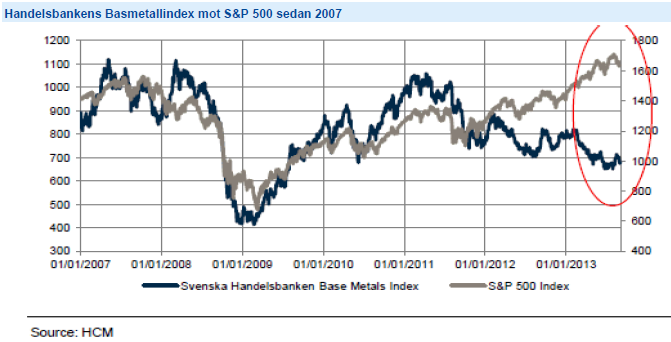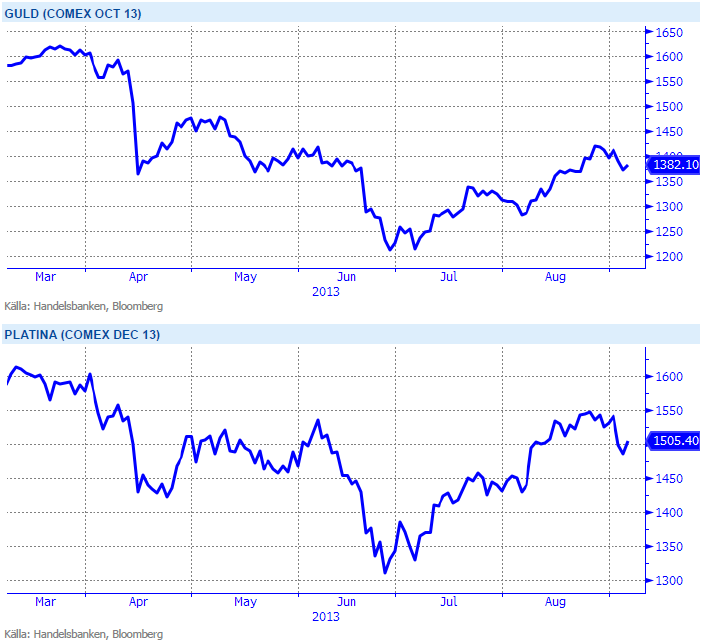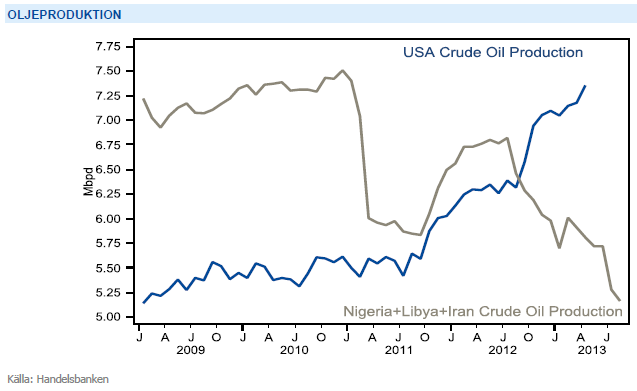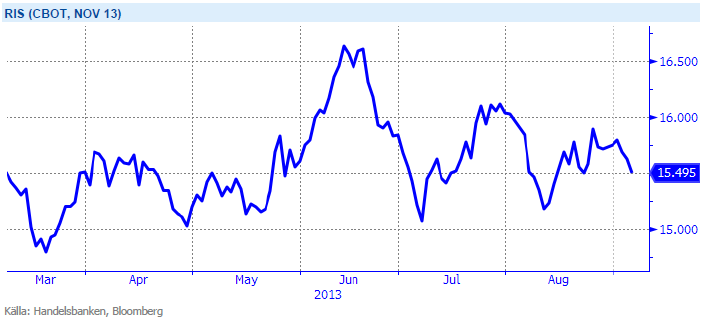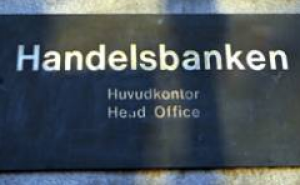Analys
SHB Råvarubrevet 6 september 2013
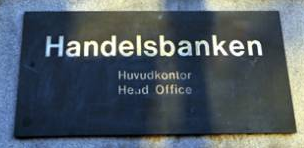
 Råvaror allmänt
Råvaror allmänt
Man petar inte på en skallerom
Risktillgångar har drabbats av viss tillbakagång under veckan när en amerikansk attack mot Syrien har blivit allt mer uppenbar. Vi gästades av FOI:s analytiker som menar att sannolikheten för en attack från Obama nu är mer än 80 %. Antingen dödar man en skallerorm eller så låter man den vara i fred; man petar inte på den. Har Obama gett sig in i argumentationen med Syrien så kommer han sannolikt att löpa hela linan ut. Den geopolitiska spänningen ökar riskpremien i olja men verkar dämpande på de flesta andra råvaror.
Globalt fortsätter makrodata att vittna om en förbättring. Veckan startade med ett bättre än väntat inköpschefsindex från Kina och slutar med bra inköpschefsindex (PMI) och arbetsmarknadsdata (jobless claims) från USA. Vårt tema med en marknad som drivs av robust makrodata håller alltså i sig, och vi tror att det fortgår några månader till. Mycket av den bra makrodatan verkar dock redan vara inprisad i många tillgångslag givet hur börsen och räntemarknaden betett sig senaste tiden. Stundande oro för råvarumarknaden är Fed:s ”tapering” som väntas tillkännages under septembermötet den 18/9. Mycket av detta torde dock vara inprisat i dagens marknad och vi fortsätter därför tro att stark makrodata får råvarorna att stiga framöver.
Basmetaller
Kina överraskar positivt
I söndags publicerades Kinas PMI med positivt resultat, 51 mot väntade 50,6, och gav basmetallerna skjuts uppåt initialt. Efter att en attack mot Syrien blir mer sannolik har dock risktillgångar som basmetaller fallit tillbaka något under veckan. Tenn har haft ett kraftigt uppsving under veckan efter exportbegränsningar från Indonesien, värdens störta exportör. Indonesien har i sin ambition att öka de inhemska smältlönerna stoppat exporten av tenn. Dels höjer man den för export godkända halten samtidigt som man försöker stimulera den lokala handeln och landets möjligheter att behålla ett större värde av landets värdefulla naturtillgångar. Detta har tvingat PT Timah, världens tredje största producent, att åberopa force majeure sedan den 30 augusti. Låga lager och inställda leveranser från Indonesien har skickat upp priset på tenn till fem månaders högsta och har under veckan stigit med dryga 6,2 %.
Under första halvan av året har utvecklingen på basmetaller och aktiemarknaden gått ordentligt isär, bilden nedan visar utvecklingen på Handelsbankens Basmetallindex mot S&P 500 sedan 2007. Även om amerikansk och europeisk makro signalerat återhämtning under en tid, verkar den kinesiska ekonomin varit i kontraktion fram till juli/augusti i år vilket pressat efterfrågan och priserna på metaller. De senaste veckorna har vi dock sett tecken på att den kinesiska tillväxten kan ta fart igen där några fundamentala rörelser är intressanta att notera, framför allt på koppar. Kinas kopparimport har återigen ökat och såväl inhemska som globala lager har minskat samtidigt som investerare täckt sina korta positioner. När den värsta oron för ett överutbud nu avtagit samtidigt som lagren minskar anser vi att metallpriserna bör ha bottnat ur under Q2 2013 och att en ökande efterfrågan bör resultera i högre metallpriser överlag under hösten.
Kinas kopparimport har återigen ökat och såväl inhemska som globala lager har minskat samtidigt som investerare täckt sina korta positioner. Vi tror på: LONG KOPPAR
Ädelmetaller
På guldfronten intet nytt!
Efter dagens rykande färska arbetslöshetsstatistik från USA, nonfarm payrolls som kom in något sämre än väntat, handlar guldet på 1390 dollar per uns, att jämföra med förra fredagens 1390 dollar per uns… Veckan har präglats av små rörselser i brist på nya nyheter i Syrienfrågan och i linje med en avvaktande hållning på de flesta marknaderna. Vi bibehåller vår positiva syn på guldet i det kortare perspektivet, och vår negativa syn i det längre perspektivet. Platina har tappat marginellt under veckan som gått.
I ett läge där råvaror generellt har viktats ned av institutionella placerare kan guld och silver få en ”omotiverad” uppgång när dessa indexköpare återvänder till råvaror drivit av bättre utsikter för Kina och USA. Vi tror på: LONG GULD H och LONG SILVER H
Energi
Fortsatt Syrienattack i fokus
Oljan ligger kvar på höga nivåer där oron för utbudsstörningar i Mellanöstern och sannolikheten att att USA slår tillbaka på al-Assad regimen kvarstår. Buy the rumour sell the fact brukar ju vara en gyllene regel där vi tidigare sett riskpremien pysa ut ganska hastigt efter både Libyen- och Irankonflikten. Även om så sker efter en eventuell intervention, ser vi flera faktorer som kan skrämma upp oljepriset ytterligare. Den globala reservkapaciteten är endast 1.3 miljoner fat per dag och vi ställer oss frågande till om Saudiarabien, som redan idag producerar på rekordnivå, verkligen kan täcka upp för det kraftiga produktionsbortfallet från Nigeria, Libyen och Iran (se bilden nedan). Även Irak har minskat sin produktion de senaste 12 månaderna och denna osäkerhet anser vi väl motiverar nuvarande riskpremie. Lägg därtill positiv amerikansk makrostatistik vilket i kombination med vikande råoljelager för nionde veckan i rad bör skapa en hel del rörelser på uppsidan. Vår rekommendation om lång position kvartsår.
Elmarknaden och kvartalet Q1 2014 (som nu är underliggande för Handelsbankens elindex och investeringsprodukter) stiger med närmare 6 procent denna vecka. Uppgången inleddes med att Oskarshamnsverket 3 oväntat föll ur drift förra helgen vilket resulterade i att svenska kärnkraften föll tillbaka på 58 procents output. Det torra scenario vi såg mot slutet av förra veckan låg kvar över helgen vilket genererade en hel del köpintresse. Vidare har såväl bränslekomplex, utsläppsrätter och Tyska marknaden där vi sett en del shortcovering stärkts vilket gjort att vi tagit oss igenom tidigare motståndsnivåer. Vädret spelar till stor del in och begränsar nedsidan på de två kommande kvartalskontrakten. Senaste väderprognoserna pekar på ett kraftigt underskott i nederbörden de kommande 10-dagarna vilket i skrivande stund ser ut att försämra energibalansen med 5-6 TWh ned till -13 TWh. Vi ligger därför kvar med lång rekommendation.
Oroligheterna i mellanöstern med risk för ytterligare produktionsbortfall ger stöd till oljepriset. Vi tror på: LONG OLJA
Livsmedel
Goda skördar pressar rispriset
Spannmålspriserna har den senaste tiden påverkats i hög grad av väderutvecklingen i USA. Majsen, men främst sojan som inte kommit lika långt i sin utveckling, har påverkats negativt av torrt och varmt väder och risken för nedjusteringar av kommande skörd har ökat. Väderprognoserna har varierat en del och priserna likaså – regn i sikte har pressat ned prisnivån något men nya prognoser om åter minskad nederbörd har lätt skapat ett uppsving igen.
Kakao tillhör den råvara i vårt livsmedelindex som gått bäst sedan årsskiftet. SHB Cocoa har gått upp drygt 8,5 procent som följd av bl.a. torrt väder och minskad skörd i Afrikas västkust. Under veckan har kakaopriset fått ytterligare stöd och nådde 11-månaders högsta efter nya väderrapporter som visat på halverat skyfall för de senaste 30 dagarna jämfört med ett normalår.
En annan mjuk råvara som haft ett volatilt år är ris. Underliggande terminen till SHB Rice är Rough Rice som handlas på Chicago börsen och där ett kontrakt motsvarar 2000 CWT (ca 90 kg). De globala lagren på ris väntas stiga till 107,47 miljoner ton för säsong 2013-14 – vilket är i så fall den högsta siffran på 12 år. Förväntningarna på den kommande globala risproduktionen för säsong 2013-14 visar på en ökning med 1,9 procent från tidigare säsong, enligt den senaste rapporten från amerikanska jordbruksdepartementet. Förhållandet mellan utgående lager i förhållande till årlig konsumtion är 22,6 procent. Den höga siffran visar på välfyllda rislager för säsongen varför vi tror på fallande priser.
Förväntningar på den kommande risproduktionen är stor och prognoser visar på välfyllda lager. Vi tror på: SHORT RIS
Handelsbankens Råvaruindex

Handelsbankens råvaruindex består av de underliggande indexen för respektive råvara. Vikterna är bestämda till hälften från värdet av nordisk produktion (globala produktionen för sektorindex) och till hälften från likviditeten i terminskontrakten.
[box]SHB Råvarubrevet är producerat av Handelsbanken och publiceras i samarbete och med tillstånd på Råvarumarknaden.se[/box]
Ansvarsbegränsning
Detta material är producerat av Svenska Handelsbanken AB (publ) i fortsättningen kallad Handelsbanken. De som arbetar med innehållet är inte analytiker och materialet är inte oberoende investeringsanalys. Innehållet är uteslutande avsett för kunder i Sverige. Syftet är att ge en allmän information till Handelsbankens kunder och utgör inte ett personligt investeringsråd eller en personlig rekommendation. Informationen ska inte ensamt utgöra underlag för investeringsbeslut. Kunder bör inhämta råd från sina rådgivare och basera sina investeringsbeslut utifrån egen erfarenhet.
Informationen i materialet kan ändras och också avvika från de åsikter som uttrycks i oberoende investeringsanalyser från Handelsbanken. Informationen grundar sig på allmänt tillgänglig information och är hämtad från källor som bedöms som tillförlitliga, men riktigheten kan inte garanteras och informationen kan vara ofullständig eller nedkortad. Ingen del av förslaget får reproduceras eller distribueras till någon annan person utan att Handelsbanken dessförinnan lämnat sitt skriftliga medgivande. Handelsbanken ansvarar inte för att materialet används på ett sätt som strider mot förbudet mot vidarebefordran eller offentliggörs i strid med bankens regler.
Analys
Tightening fundamentals – bullish inventories from DOE

The latest weekly report from the US DOE showed a substantial drawdown across key petroleum categories, adding more upside potential to the fundamental picture.

Commercial crude inventories (excl. SPR) fell by 5.8 million barrels, bringing total inventories down to 415.1 million barrels. Now sitting 11% below the five-year seasonal norm and placed in the lowest 2015-2022 range (see picture below).
Product inventories also tightened further last week. Gasoline inventories declined by 2.1 million barrels, with reductions seen in both finished gasoline and blending components. Current gasoline levels are about 3% below the five-year average for this time of year.
Among products, the most notable move came in diesel, where inventories dropped by almost 4.1 million barrels, deepening the deficit to around 20% below seasonal norms – continuing to underscore the persistent supply tightness in diesel markets.
The only area of inventory growth was in propane/propylene, which posted a significant 5.1-million-barrel build and now stands 9% above the five-year average.
Total commercial petroleum inventories (crude plus refined products) declined by 4.2 million barrels on the week, reinforcing the overall tightening of US crude and products.


Analys
Bombs to ”ceasefire” in hours – Brent below $70

A classic case of “buy the rumor, sell the news” played out in oil markets, as Brent crude has dropped sharply – down nearly USD 10 per barrel since yesterday evening – following Iran’s retaliatory strike on a U.S. air base in Qatar. The immediate reaction was: “That was it?” The strike followed a carefully calibrated, non-escalatory playbook, avoiding direct threats to energy infrastructure or disruption of shipping through the Strait of Hormuz – thus calming worst-case fears.

After Monday morning’s sharp spike to USD 81.4 per barrel, triggered by the U.S. bombing of Iranian nuclear facilities, oil prices drifted sideways in anticipation of a potential Iranian response. That response came with advance warning and caused limited physical damage. Early this morning, both the U.S. President and Iranian state media announced a ceasefire, effectively placing a lid on the immediate conflict risk – at least for now.
As a result, Brent crude has now fallen by a total of USD 12 from Monday’s peak, currently trading around USD 69 per barrel.
Looking beyond geopolitics, the market will now shift its focus to the upcoming OPEC+ meeting in early July. Saudi Arabia’s decision to increase output earlier this year – despite falling prices – has drawn renewed attention considering recent developments. Some suggest this was a response to U.S. pressure to offset potential Iranian supply losses.
However, consensus is that the move was driven more by internal OPEC+ dynamics. After years of curbing production to support prices, Riyadh had grown frustrated with quota-busting by several members (notably Kazakhstan). With Saudi Arabia cutting up to 2 million barrels per day – roughly 2% of global supply – returns were diminishing, and the risk of losing market share was rising. The production increase is widely seen as an effort to reassert leadership and restore discipline within the group.
That said, the FT recently stated that, the Saudis remain wary of past missteps. In 2018, Riyadh ramped up output at Trump’s request ahead of Iran sanctions, only to see prices collapse when the U.S. granted broad waivers – triggering oversupply. Officials have reportedly made it clear they don’t intend to repeat that mistake.
The recent visit by President Trump to Saudi Arabia, which included agreements on AI, defense, and nuclear cooperation, suggests a broader strategic alignment. This has fueled speculation about a quiet “pump-for-politics” deal behind recent production moves.
Looking ahead, oil prices have now retraced the entire rally sparked by the June 13 Israel–Iran escalation. This retreat provides more political and policy space for both the U.S. and Saudi Arabia. Specifically, it makes it easier for Riyadh to scale back its three recent production hikes of 411,000 barrels each, potentially returning to more moderate increases of 137,000 barrels for August and September.
In short: with no major loss of Iranian supply to the market, OPEC+ – led by Saudi Arabia – no longer needs to compensate for a disruption that hasn’t materialized, especially not to please the U.S. at the cost of its own market strategy. As the Saudis themselves have signaled, they are unlikely to repeat previous mistakes.
Conclusion: With Brent now in the high USD 60s, buying oil looks fundamentally justified. The geopolitical premium has deflated, but tensions between Israel and Iran remain unresolved – and the risk of missteps and renewed escalation still lingers. In fact, even this morning, reports have emerged of renewed missile fire despite the declared “truce.” The path forward may be calmer – but it is far from stable.
Analys
A muted price reaction. Market looks relaxed, but it is still on edge waiting for what Iran will do

Brent crossed the 80-line this morning but quickly fell back assigning limited probability for Iran choosing to close the Strait of Hormuz. Brent traded in a range of USD 70.56 – 79.04/b last week as the market fluctuated between ”Iran wants a deal” and ”US is about to attack Iran”. At the end of the week though, Donald Trump managed to convince markets (and probably also Iran) that he would make a decision within two weeks. I.e. no imminent attack. Previously when when he has talked about ”making a decision within two weeks” he has often ended up doing nothing in the end. The oil market relaxed as a result and the week ended at USD 77.01/b which is just USD 6/b above the year to date average of USD 71/b.

Brent jumped to USD 81.4/b this morning, the highest since mid-January, but then quickly fell back to a current price of USD 78.2/b which is only up 1.5% versus the close on Friday. As such the market is pricing a fairly low probability that Iran will actually close the Strait of Hormuz. Probably because it will hurt Iranian oil exports as well as the global oil market.
It was however all smoke and mirrors. Deception. The US attacked Iran on Saturday. The attack involved 125 warplanes, submarines and surface warships and 14 bunker buster bombs were dropped on Iranian nuclear sites including Fordow, Natanz and Isfahan. In response the Iranian Parliament voted in support of closing the Strait of Hormuz where some 17 mb of crude and products is transported to the global market every day plus significant volumes of LNG. This is however merely an advise to the Supreme leader Ayatollah Ali Khamenei and the Supreme National Security Council which sits with the final and actual decision.
No supply of oil is lost yet. It is about the risk of Iran closing the Strait of Hormuz or not. So far not a single drop of oil supply has been lost to the global market. The price at the moment is all about the assessed risk of loss of supply. Will Iran choose to choke of the Strait of Hormuz or not? That is the big question. It would be painful for US consumers, for Donald Trump’s voter base, for the global economy but also for Iran and its population which relies on oil exports and income from selling oil out of that Strait as well. As such it is not a no-brainer choice for Iran to close the Strait for oil exports. And looking at the il price this morning it is clear that the oil market doesn’t assign a very high probability of it happening. It is however probably well within the capability of Iran to close the Strait off with rockets, mines, air-drones and possibly sea-drones. Just look at how Ukraine has been able to control and damage the Russian Black Sea fleet.
What to do about the highly enriched uranium which has gone missing? While the US and Israel can celebrate their destruction of Iranian nuclear facilities they are also scratching their heads over what to do with the lost Iranian nuclear material. Iran had 408 kg of highly enriched uranium (IAEA). Almost weapons grade. Enough for some 10 nuclear warheads. It seems to have been transported out of Fordow before the attack this weekend.
The market is still on edge. USD 80-something/b seems sensible while we wait. The oil market reaction to this weekend’s events is very muted so far. The market is still on edge awaiting what Iran will do. Because Iran will do something. But what and when? An oil price of 80-something seems like a sensible level until something do happen.
-

 Nyheter3 veckor sedan
Nyheter3 veckor sedanMahvie Minerals växlar spår – satsar fullt ut på guld
-

 Nyheter4 veckor sedan
Nyheter4 veckor sedanUppgången i oljepriset planade ut under helgen
-

 Nyheter4 veckor sedan
Nyheter4 veckor sedanLåga elpriser i sommar – men mellersta Sverige får en ökning
-

 Nyheter3 veckor sedan
Nyheter3 veckor sedanJonas Lindvall är tillbaka med ett nytt oljebolag, Perthro, som ska börsnoteras
-

 Analys3 veckor sedan
Analys3 veckor sedanA muted price reaction. Market looks relaxed, but it is still on edge waiting for what Iran will do
-

 Nyheter3 veckor sedan
Nyheter3 veckor sedanOljan, guldet och marknadens oroande tystnad
-

 Analys4 veckor sedan
Analys4 veckor sedanVery relaxed at USD 75/b. Risk barometer will likely fluctuate to higher levels with Brent into the 80ies or higher coming 2-3 weeks
-

 Nyheter3 veckor sedan
Nyheter3 veckor sedanDomstolen ger klartecken till Lappland Guldprospektering



